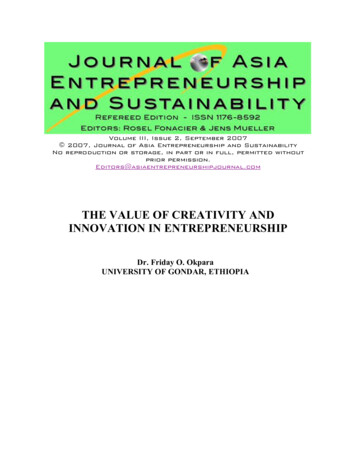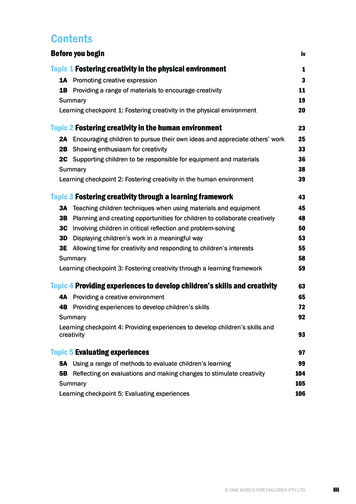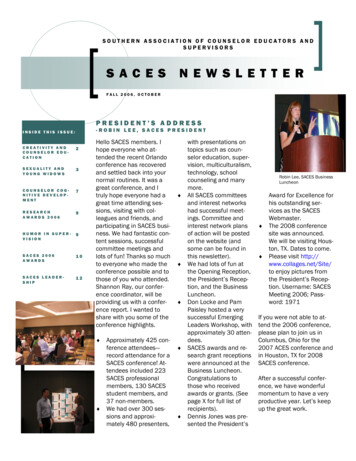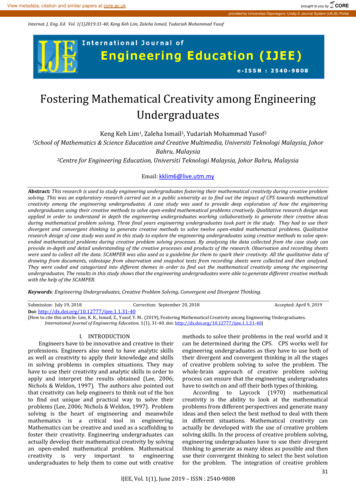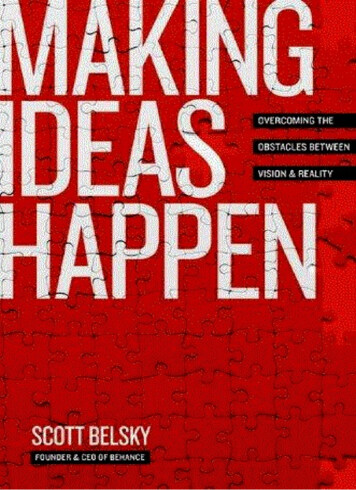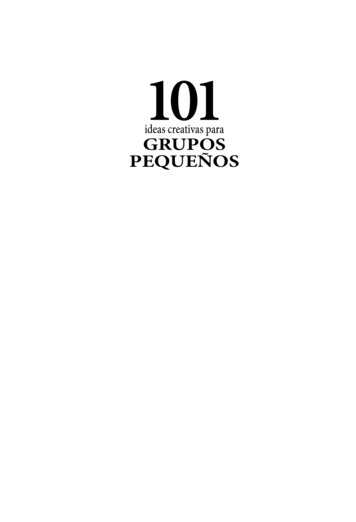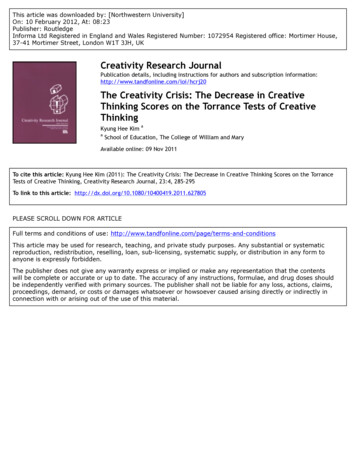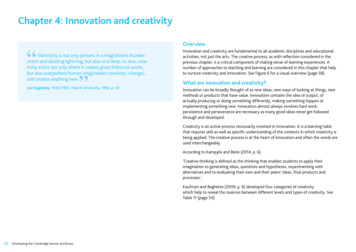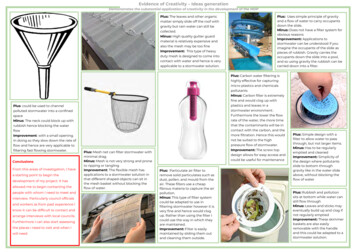
Transcription
Evidence of Creativity – Ideas generationDemonstrates the substantial application of creativity in the development of the MDPPlus: The leaves and other organicmatter simply slide off the roof withgravity but rain water can still becollected.Minus: High quality gutter guardmaterial is relatively expensive andalso the mesh may be too fineImprovement: This type of heavyduty mesh is designed to come intocontact with water and hence is veryapplicable to a stormwater solution.Plus: could be used to channelpolluted stormwater into a confinedspaceMinus: The neck could block up withrubbish hence blocking the waterflowImprovement: with a small opening.In doing so they slow down the rate offlow and hence are very applicable tofiltering fast flowing stormwater.ConclusionsFrom this areas of investigation, I havea starting point to begin thedevelopment of my project. It hasallowed me to begin contacting thepeople with whom I need to meet andinterview. Particularly council officialsand workers as from past experience Iknow it can be difficult to contact andarrange interviews with local councils.Furthermore I can also start assessingthe places i need to visit and when Iwill needPlus: Mesh net can filter stormwater withminimal drag.Minus: Mesh is not very strong and proneto ripping or tanglingImprovement: The flexible mesh hasapplications to a stormwater solution inthat different shaped objects can sit inthe mesh basket without blocking theflow of water.Plus: Uses simple principle of gravityand a flow of water to carry occupantsdown the slide.Minus: Does not have a filter system forobvious reasonsImprovement: Applications tostormwater can be understood if youimagine the occupants of the slide aspieces of rubbish. Gravity carries theoccupants down the slide into a pool,and so using gravity the rubbish can becarried down into a filter.Plus: Carbon water filtering ishighly effective for capturingmicro plastics and chemicalspollutantsMinus: Carbon filter is extremelyfine and would clog up withplastics and leaves in astormwater environment .Furthermore the lower the flowrate of the water, the more timethat the contaminants will be incontact with the carbon, and themore filtration. Hence this wouldnot be suited to the highpressure flow of stormwater.Improvement: The screw topdesign allows for easy access andcould be useful for maintenancePlus: Particulate air filter toremove solid particulates such asdust, pollen, and mould from theair. These filters use a cheapfibrous materia to capture the airpollution.Minus: This type of filter systemcould be adapted to use infiltering stormwater however it isvery fine and hence would clogup. Rather than using the filter Icould use the way in which theyare maintained.Improvement: Filter is easilymaintained by sliding them outand cleaning them outside.Plus: Simple design with afilter to allow water to passthrough, but not larger items.Minus: Has to be regularlyemptied and cleanedImprovement: Simplicity ofthe design where pollutantsslide to bottom throughgravity like in the water slideabove, without blocking theflow of waterPlus: Rubbish and pollutionsits at bottom while water canstill flow throughMinus: Leaves and sticks mayeventually build up and clog ifnot regularly emptiedImprovement: These skimmerbaskets are also easilyremovable with the handleand this could be adapted to astormwater solution.
Evidence of Creativity – Ideas generation#3#1#2ConclusionsThe three initial sketches that I will further develop and test from these sketch board are ;Firstly sketch #1, which originated from the gutter guard image. I chose this idea because of the simplicity inseparating the stormwater and pollution without the problem of blockage. Because the rubbish slides down across the mesh guard while the water can flow through and into a gutter. The secondsketch I chose was sketch #2 which originated from the funnel which the rubbish captures at the bottom of the cone shape while the water can flow through, hence minimising chance of blockage. Thethird sketch chosen was sketch #3 of using as multi layer filter system to capture different pollution at different stages.
Evidence of Creativity – Ideas refinementDesign # 1Design # 2Design # 3ConclusionsConclusionsConclusionsThis design does reduce the chance of blockage however I stillSimilar to design #2 however the multi-layered filter systemSimple use of gravity to separate rubbish and stormwater. Alsothink that rubbish would depend on the amount spent andcaptures different sizes of rubbish at different stages. Howeverthe separate catchment basin reduces change of rubbish andhow quickly that can build up but again this depends wetp atthis design would be difficult to empty and clean due to themake it easier to maintain. However angle could be madethe bottom of the cone. The cone shape could be made deeperlayered design.steeper so rubbish slides down faster.to hold more captured rubbish.
Evidence of Creativity – Ideas modellingIn order to further develop and refine my three designs from my image board. I have made some basic models of each three designs. This modelling process will allow me undergo practical testing ofeach design and then assess their effectiveness. For the modelling I used Whites Fire Guard 2mm Gauze for the modelling at it is easy to cut and shape by hand.Aim: To make models of three initial designs in order to conduct practical testingMethod Design # 11.A 3D cone with a diameter of 30mm and a height ofMethod Design # 21.50mm was drawn up on Sketchup2.The cone was then printed using the 3D printer3.A sheet of wire gauze / mesh was moulded around thecone4.1.50mm was drawn up on Sketchup2.3.Excess mesh was cut off the edges and the cone mouldwas removedA 3D cone with a diameter of 30mm and a height ofMethod Design # 3and 10mm high was marked on a sheet of mesh gauzeA second 3D cone with a diameter of 40mm and a2.The net was cut out and folded togetherheight of 60mm was drawn up on Sketchup3.Step 1 and 2 were repeated on a second rectangle withA third 3D cone with a diameter of 50mm and a height of60mm was drawn up on Sketchup4.All three cones was then printed using the 3D printer5.A sheet of wire gauze / mesh was moulded around eachcone6.A rectangle net with no top and dimensions 50 x 50mmsame height of 10mmt but dimensions 40 x 40mm4.Step 1 and 2 were repeated on a second rectangle withsame height of 10mm but dimensions 30 x 30mm5.The three rectangles were stacked on top of each otherwith the smallest rectangle at the bottomExcess mesh was cut off the edges and each cone mouldwas removedConclusionsThe mesh was very easy to mould by hand, however the edges of the mesh were sharp and so I had to use gloves to prevent myself from being cut. The mesh did not fit very well to the cone and so i hadto use some black wire to join the mesh and hold the cone in shape. My next step is testing these design with water and plastic. My prediction is that the Design #1 will be the least effective and theplastic will all build up at the point of the cone, then Design #3 will be the effective however i think under large water flows this could block up and overflow. Finally I think Design #3 will be the mosteffective as it incorporates the cone design but is also layered like Design #3.
Evidence of Creativity – Exploration of existingideasUltraTech is international company formed in 1993 initially specialising in Spill Containment solutions. Since then it has expanded into additional product categories particularly into Stormwatermanagement. Their Stormwater Management product line features an array of products designed to filter contaminants such as sediment, oil and chemicals from Stormwater runoff, stop hazardousspills from entering storm drains and to protect drums and tanks from outdoor elements. The following three products are from this product line.Existing ProductsUltra-Drain Guard Plus Ultra-Curb Guard Ultra-Debris Screen Adjustable catch basin insert quickly re-sizesto fit almost any storm drain meaning thatno trimming of excess filter fabric is requiredSolid steel frame prevents it from falling intothe basin even when the grate is liftedLightweight design means that it can beeasily lifted out and maintainedVery fine filter fabric captures all forms ofpollution including micro-plasticIntercepts sediment, oil, silt and debris beforethey enter curb inlets and stormwatersystemsFiltering material is quickly and easilyreplaced.Heavy-duty tension rods keep unit securedinside inlet for a clean, flush-mountedinstallation.Inexpensive solutionPolyethylene frame and stainless steel screenunit quickly installs over stormwater outflowHeavy-duty, polyethylene housing will notrust or corrodePolyethylene housing is much moreeconomical than similar all stainless steelunitsPolyethylene housing is made with 86%recycled contentQuickly attaches to catch basin walls withincluded concrete screwsMinus Improvement and Design ApplicationWhile the very fine filter fabric captures all formsof pollution it also means that it can block upquicker potentially resulting in flooding of thedrainOnly designed for street pit drains and notcurbside drains, furthermore the majority ofstormwater drains in Sydney are curbside drainsHeavy grate has to be lifted off to empty the filterresulting in a maintenance nightmare The pollution is not actually captured instead it issimply blocked from entering the curb drain. Thisleaves the pollution on the street allowing it toflow down another unfiltered stormwater drainFine filtering material would not cope with thepressure of stormwater flow potentially leading tofloodingUnit is not adjustable to suit different curbsidedrains and The pollution is not actually captured instead it issimply blocked from entering the curb drain. Thisleaves the pollution on the street allowing it toflow down another unfiltered stormwater drainPolyethylene frame is not as strong as a steelframe and could potentially be cracked ordamagedOnly designed for stormwater pipes and notcurbside drains, furthermore the majority ofstormwater drains in Sydney are curb-side drains The design of funneling the stormwater into acentral catchment bagThe choice of filter material is very fine andwould capture micro-plasticsAdjustable steel frame allows it to be re-sizedto fit almost any storm drainHeavy-duty lifting handles on either side allowit to be easily lifted out by one personSteel frame can be reused and the Filter Fabriccan be easily replacedBlocking the pollution before it even enters thestormwater drainFabric style filtering material captures micropollution such as sediment and microplasticsFabric is inexpensive and easy to replace inSteel frame, making it more appealable to localcouncils in regards to maintenanceLeaves the pollution on the street to show thepublic the problem of stormwater pollutionAllows stormwater to pass through freely whilekeeping litter, leaves and other debris fromescapingLeaves the pollution on the street to potentiallyshow the public the amount of pollution thatenters the stormwater systemUse of recycled materials being made from86% recycled contentStainless steel screen to filter the stormwaterConclusionsThe Ultra-Drain Guard is effective at capturing pollution however it poses a maintenance nightmare. As it has to be lifted out and maintain by hand which would be a laborious process emptyinghundreds if not thousands of these filters. The Ultra-Curb Guard and Ultra-Debris Screen are interesting in that they simply stop the pollution from entering the stormwater system in the first placeand don’t actually capture any pollution. This simply leaves the pollution on the street, potentially allowing this pollution to flow down another unfiltered stormwater drain. Despite these problems Ihave decided to develop two of these existing products further. Firstly the Ultra-Drain Guard , because of the design of funneling the stormwater into a central catchment bag. Secondly the Ultra-CurbGuard because of the interesting material use of a fabric style filtering material.
Evidence of Creativity – Exploration of existingideasStormwater360 is a leading New Zealand owned and operated stormwater management and green infrastructure company. The company has developed and delivered efficient, innovative andaward-winning solutions to manage stormwater runoff and reduce its impact on the environment. They offer complete stormwater management for any site - from engineering design and productsupply, through to implementation and maintenance. They have an extensive product range and the following three products are from that range.Existing ProductsEnviroPod Plus LittaTrap StormFilter MinusNo installation construction, resulting in lowcosts. Making it one of the lowest capital cost ofany stormwater treatment deviceA range of filter sizes to target gross pollutantsto fine sedimentDurable heavy-duty wire construction of thecatch pitCan be installed in either a kerb inlet or drop-incatch basinClaims to be retrofittable to existing drainsSimple concept Efficient and simplemaintenance Simple catch basin designTwo standard sizes to fit most pre-cast regularand curb entry catchpitsFits both curb inlet and flat-grate catchpitsNo installation construction means low capitalcostsA range of filter sizes to target gross pollutantsHand maintainable - simply lift out, tip thenreplace Has a high removal rate of fine sediments,heavy metals and nutrientsCompact design reduces construction andinstallation costs by limiting excavationReliable performance, long lifespan & lowermaintenance costsNo standing waterOnly needs to be maintained every 1-3 yearsSelf-cleaning design prolongs the life of thefilter cartridge Improvement and Design ApplicationOnly captures large plastic debris such asbottles while smaller micro-plastics flowthroughAlthough simple to maintain, it would bedifficult to individually empty several hundredof these over several council suburbsAlthough it claims to be retrofittable theconstruction is not adjustable so unless acustom order was available which is moreexpensive it is not in fact very retrofittable Plastic construction may not be strong enoughto endure the pressure of stormwaterAlthough it is hand maintainable, it would bedifficult to individually empty several hundredof these over several suburbsThe goss pollutant filter bag could be prone toripping or breaking once it full or under heavystormwater flow because it is made of arelatively light filter material Very large upfront capital cost to firstlypurchase and then installNot retrofittable to all existing stormwatersystems and locationsAlthough the manufacturer claims that it needsto be maintained every 1-3 years. It still has tobe regularly emptied.Most councils are looking for a inexpensiveretrofittable solution but the StormFilter isexpensive to both purchase and a large scaleoperation to install The heavy wire construction is durable andrelatively cheap materialSimple drop in catch basin design so it does notrequire any screwing or drilling to install to anexisting drainThe customisable option of various meshscreen sizes allow it to be adapted to the areawhere it is to be installed where one particulartype of rubbish is more common i.e. in an areawhere cigarette butts are common a smallermest would be bestThe simple use of handles allows it to be easilyinstalled and maintainedAlthough the manufacturer claims that it beinghand maintainable is an advantage I think I willsteer away from this approach becausemaintaining several hundred filters by handwould pose a maintenance nightmare so mynext step is researching different types ofautomated maintenance solutions and how Icould adapt theseI want to further investigate the use of filtercartridges to absorb that can retain the mostchallenging pollutants from stormwater runoffincluding total suspended solids, hydrocarbons,heavy metals, and other common pollutants.While this solution is extremely effective atcompletely filtering stormwater flow it wouldconsiderably slow down the water flowpotentially leading to floodingConclusionsThe Enviropod is a durable and cheap solution, however it only catches large plastic debris such as bottles and smaller pollutants will go through unfiltered. However i think the simple drop in design issomething I should look at developing further. The Litttatrap is however I am not convinced regarding its quality and durability to endure heavy and relentless stormwater pressures. Finally theStormfilter is a very effective solution however is very expensive and a large operation to install, and most councils are looking for a inexpensive retrofittable solution. The two existing products that I willbe developing further are the Enviropod and Littatrap. The next step is collating the chosen existing products from the last three pages and developing ideas and sketches as i did previously with thethe mood board.
Evidence of Creativity – Ideas generation#4#5#6ConclusionsThe three initial sketches that I will further develop and test from these sketch board are: Firstly sketch #1, which originated from the Ultra-Drain Guard. I chose this idea because of sloped design whichconcentrates the rubbish collection a single point. Because the rubbish slides down across the fabric guard while the water can flow through. The second sketch I chose was sketch #2 which originatedfrom the floating litter trap, I chose this because of interesting multi layered filter system to capture different pollution at different stages.The third sketch chosen was sketch #3 which also originatedfrom the the floating litter trap, which utilises a one way flap meaning rubbish can flow through into a collection basket but not overflow back out.
Evidence of Creativity – Ideas refinementDesign # 4Design # 5Design # 6ConclusionsConclusionsConclusionsThe slope design does concentrate the rubbish into the bag,The layered design is interesting as it staggers the filtrationThe swing design could be very effective at preventing thehowever I will have to figure out how this idea can beprocess. However with my previous idea testing the conerubbish from clogging back up the drain. However as with anycontained within a single system. Also I will have to figure outdesign was not very effective as it blocked at the vertexmoving parts in an outdoor water environment there is highthe most effective angle for the ramp / slide.however this variation of horizontal layers may prove to bechange of the gate getting jammed or corroding.more effective.
Evidence of Creativity – Ideas modellingIn order to further develop and refine my three designs from existing products I have made some basic models of each three designs. This modelling process will allow me undergo practical testing ofeach design and then assess their effectiveness. For the modelling I used Whites Fire Guard 3mm Gauze for the modelling at it is easy to cut and shape by hand.Aim: To make models of three initial designs in order to conduct practical testingMethod Design # 41.A rectangle net 180mm x 50 x 10 and no top with wasMethod Design # 51.marked on wire gauzeA 3D cone with a diameter of 30mm and a height ofMethod Design # 61.50mm was drawn up on SketchupA rectangle net with not top and dimensions 60 x 50 x 10mm was marked on a sheet of mesh gauze2.The net was cut out and folded together2.The cone was then printed using the 3D printer2.The net was cut out and folded together3.At ¾ of the length the rectangle was bent at an angle of3.A net of wire gauze / mesh was moulded around the3.A 40 x 48 mm rectangle was cut outcone4.The length of the rectangle was folded halfway at 90 Excess mesh was cut off the edges and the cone mould5.The folded piece was placed inside the original 3D45 4.The end of the rectangle was folded up4.was removedrectangle and attached on a hinge of wire allowing it to5.A mesh circle with a diameter of 20mm was cut outmove freely6.A second mesh circle with a diameter of 15mm was cutout7.The two mesh circle were slotted inside the cone at anangle of 15 ConclusionsMaking these prototypes took no time at all and my next step is testing these design with water and plastic. My prediction is that the Design #1 will be the most effective as it simple but that the rampmay need to be steeper to make the rubbish slide down fast. Then I think Design #3 will be the second most effective however if the swinging gate james then it will be completely ineffective and justresult in further blockages. Finally I think Design #2 will be the least effective based on my previous tests with a similar layered cone design, as the rubbish just accumulates at the vertex and this buildof pressure is likely to cause structural weaknesses under heavy stormwater flows.
Design selection & Degree of differenceIn order to further develop and refine my three designs from existing products I have made some basic models of each three designs. This modelling process will allow me undergo practical testing ofeach design and then assess their effectiveness. For the modelling I used Whites Fire Guard 3mm Gauze for the modelling at it is easy to cut and shape by hand.Features of imageboard designFeatures of imageboard design#11Sloped design allows rubbish toLayered design catches rubbishslide down into collection pit butat multiple stages thereforethe water can still flow throughreducing change of blockageVery little chance of slowing downEach layer is independent of thestormwater flow as the water canothers allowing for easy cleaningsimply though meshSloped designof each layer and if one fails theallows rubbish toStructurally weak, needs a frameslide downto enclose the whole designCubic shape fits squaredrains and encloses designHow willSlope /Ramp tooshortCollection pit too shallow? WouldSlope / Rampfill up quickly and overflow.shorter and3D print frame and thenfill sides using meshother two will still be workingNext step is to research how this designcould be integrated into existing drain pitspanelssteepermesh beFrame withCollection pit nowattachedpanels fordeeper and wideto sides?mesh to slot in larger capacityAlso researchdifferentmaterialsframe couldbe madefromMy design capturesMy design has a muchpollution instead oflarger catchmentsimply blocking itbasin reducing thefrom entering the curbneed for regulardrain, and leaving it onmaintenance.the streetDegree of differenceMy design is unique due to the theramp / slide component. Thisallows the rubbish to slide downinto a containment basket, whilethe water can flow through.Whereas in existing products therubbish simply builds at thebottom and disrupts the flow ofwater. Furthermore the cartridgedesign allows for easyMy design is considerably less likelyto block up due to the ramp / slopedesign. Also my cartridge designallows for more efficient maintenanceaccessMy design will incorporate a finer meshmaintenance and assembly. Finallyto capture smaller pollutants. Also mymy design is adaptable to sidecartridge design allows for moreentry drain inlets whereas mostefficient maintenance accessexisting solutions only fit intograted inlets.
50mm was drawn up on Sketchup 2. A second 3D cone with a diameter of 40mm and a height of 60mm was drawn up on Sketchup 3. A third 3D cone with a diameter of 50mm and a height of 60mm was drawn up on Sketchup 4. All three cones was then printed using the 3D printer 5. A sheet of wire gauze / mesh was moulded around each cone 6.
